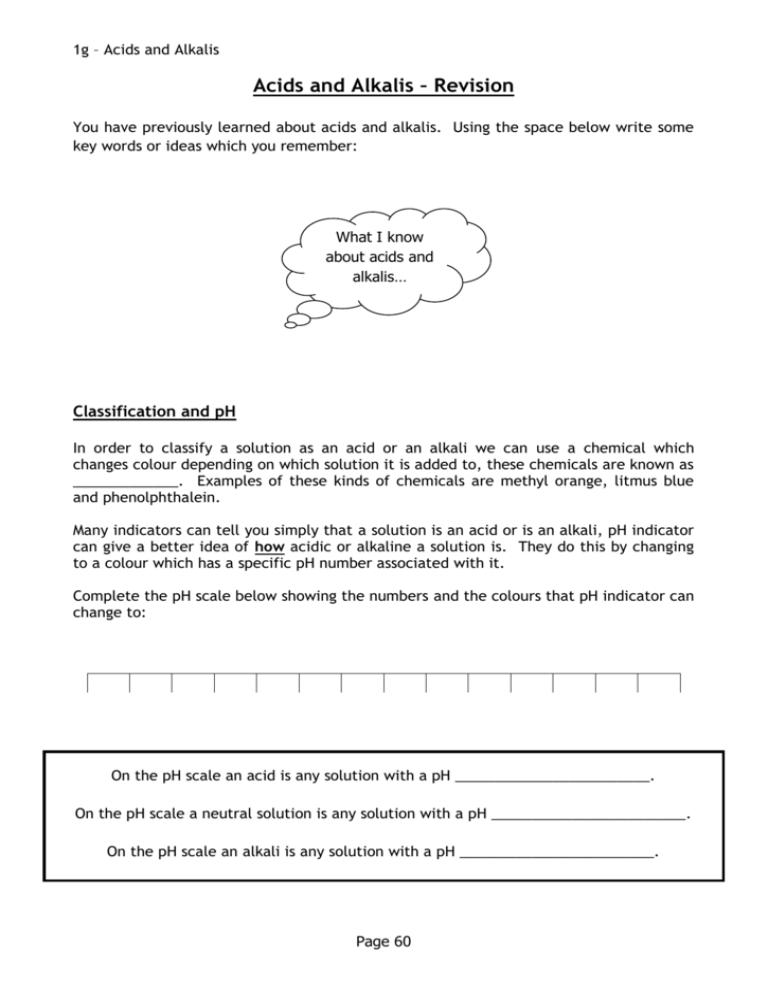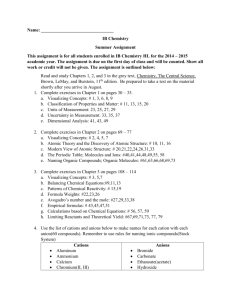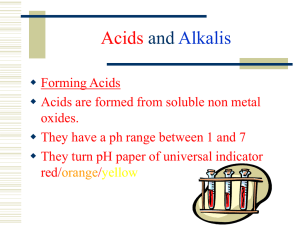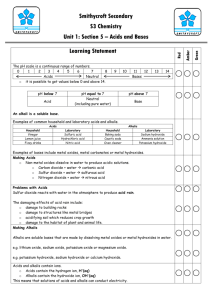Acids and Alkalis
advertisement

1g – Acids and Alkalis Acids and Alkalis – Revision You have previously learned about acids and alkalis. Using the space below write some key words or ideas which you remember: What I know about acids and alkalis… Classification and pH In order to classify a solution as an acid or an alkali we can use a chemical which changes colour depending on which solution it is added to, these chemicals are known as _____________. Examples of these kinds of chemicals are methyl orange, litmus blue and phenolphthalein. Many indicators can tell you simply that a solution is an acid or is an alkali, pH indicator can give a better idea of how acidic or alkaline a solution is. They do this by changing to a colour which has a specific pH number associated with it. Complete the pH scale below showing the numbers and the colours that pH indicator can change to: On the pH scale an acid is any solution with a pH ________________________. On the pH scale a neutral solution is any solution with a pH ________________________. On the pH scale an alkali is any solution with a pH ________________________. Page 60 1g – Acids and Alkalis Reactions of Acids – Revision Acids can take part in a number of different chemical reactions. The most common reaction an acid will take part in is a NEUTRALISATION reaction. This is a reaction in which an acid will react with another chemical producing water. In S2 these chemicals were called neutralisers; they can also be referred to as BASES. Bases include: Alkalis, these are solutions of soluble bases, common examples include metal hydroxides such as sodium hydroxide. Metal Oxides, such as calcium oxide and iron oxide. Metal Carbonates, such as sodium carbonate and copper carbonate. These react with acids producing water along with another substance known as a salt. To be classed as a neutralisation reaction, the acid must react to form water. When the base is a metal carbonate, carbon dioxide gas is also produced. ACID + ALKALI SALT + WATER ACID + METAL OXIDE SALT + WATER ACID + METAL CARBONATE SALT + WATER + CARBON DIOXIDE Naming salts The name of a salt is made up of two parts. The first part comes from the BASE and the second part from the ACID. The metal part of the salt name is simply the name of the metal element used to make the base. For example: Base First Part of Salt Name sodium hydroxide sodium calcium oxide calcium copper carbonate copper Page 61 1g – Acids and Alkalis The second part of the salt name is derived from the acid as follows: Name of acid Formula Second Part of Salt Name hydrochloric acid HCl chloride nitric acid HNO3 nitrate sulphuric acid H2SO4 sulphate You must learn this table including the chemical formulae of the acids! Name the salts formed during the following neutralisation reactions. (a) hydrochloric acid + sodium hydroxide ___________________________________ (b) sulphuric acid + potassium hydroxide ___________________________________ (c) hydrochloric acid + magnesium oxide ___________________________________ (d) nitric acid + zinc(II) oxide ___________________________________ (e) sulphuric acid +copper carbonate ___________________________________ (f) hydrochloric acid + sodium carbonate ___________________________________ Complete the following word and chemical equations: (a) hydrochloric acid + sodium hydroxide HCl + NaOH (b) sulphuric acid + magnesium oxide H2SO4 + MgO (c) nitric acid + zinc (II) carbonate HNO3 + ZnCO3 Zn(NO3)2 Check Test 1.19 Page 62 1g – Acids and Alkalis Making Acids and Alkalis Acids Acids form when a non-metal oxide dissolves in water. An example of this is in the formation of Acid Rain. Gases such as _____________ ____________ and _____________ ____________ are released in to the air as pollution from _______________ or __________________. In order to form an acid the non-metal oxide must be soluble; this means that it must _____________. Some non-metal oxides such as silicon dioxide (found in sand) are not soluble and as such they do not affect the pH of water. State the effects that acid rain can have: Alkalis The term alkali is used to describe a solution of a metal hydroxide. These solutions are formed when soluble metal oxides dissolve in water. e.g. METAL OXIDE + WATER METAL HYDROXIDE sodium oxide + water sodium hydroxide magnesium oxide + water ___________ ___________ ___________ ___________ + water calcium hydroxide Page 63 1g – Acids and Alkalis Ions in an Acid When an electric current is passed through the acid the ions will go to the electrode of the opposite charge. If we analyse what is formed at each electrode we can get some more information about the ions which are present in acids. sulphuric acid collecting gas platinum electrodes A piece of equipment known as a Hofmann voltameter is used to collect the gases which form at each electrode. The gas at the negative electrode is the same regardless of the acid used and this tells us that the positive ion must always be the same. In the space below describe the test which is carried out on the gas at the negative electrode: The gas which is collected at the negative electrode when passing electricity through an acid is ______________. This means that all acids must contain the ______________ ion. Page 64 1g – Acids and Alkalis Acid, Alkali and Neutral All acids and alkalis conduct electricity which means that they must contain ions. Water too, even in its purest form, conducts water and so it too must contain ions. These ions are produced by the splitting of a very few water molecules into ions, known as dissociation, as shown by the equation below. H2O(l) ⇌ H+(aq) + OH-(aq) The double arrow means that the reaction can go in both directions. It is reversible. Each water molecule that splits up gives one hydrogen ion (H +) and one hydroxide ion (OH-). This means in pure water, the number of H+ ions must be equal to the number of OH- ions. This allows us to form a definition for acidic, alkaline and neutral solutions: A neutral solution contains equal quantities of H+ ions and OH- ions. An acidic solution contains more H+ ions than OH- ions. An alkaline solution contains fewer H+ ions than OH- ions. 1. Pure water contains only a few ions, where do these ions come from? 2. What do the double arrows mean in the equation above? 3. Complete the following sentences. In water and any neutral solution, the concentration of hydrogen ions is _____________ to the concentration of hydroxide ions. The pH is _____. In acid solutions the concentration of ______________ ions is greater than the concentration of ______________ ions. The pH is ______________ than 7. In alkali solutions, the concentration of ______________ ions is greater than the concentration ______________ ions in water or neutral solutions. The pH is ______________ than 7. Page 65 of 1g – Acids and Alkalis What is really going on? Water is always formed in a neutralisation reaction regardless of the acid and the base used. This would imply that the same reaction is taking place each time. In order to better understand this reaction we must look at the ions involved. Acids and Alkalis Let’s examine the reaction of hydrochloric acid and potassium hydroxide. First we must write the chemical equation for the reaction: HCl(aq) + KOH(aq) KCl(aq) + H2O(l) For each of the ionic substances in solution we can write an ionic formula as these compounds will have dissociated: H+(aq) + Cl-(aq) + K+(aq) + OH-(aq) K+(aq) + Cl-(aq) + H2O(l) As you can see there are ions which appear on both sides of the equation, these are called SPECTATOR IONS as they do not take part in the reaction. If we cancel these ions we will be left with the actual reaction which is taking place: H+(aq) + Cl-(aq) + K+(aq) + OH-(aq) K+(aq) + Cl-(aq) + H2O(l) The actual reaction is H+(aq) + OH-(aq) H2O(l) Find the actual reaction taking place in the following reactions by rewriting the equation without the spectator ions. a) H+(aq) + Cl-(aq) + Na+(aq) + OH-(aq) Na+(aq) + Cl-(aq) + H2O(l) b) H+(aq) + NO3-(aq) + NH4+(aq) + OH-(aq) NH4+(aq) + NO3-(aq) + H2O(l) Complete the following: From these equations we can see that the reaction taking place during neutralisation of any acid with any alkali is that the ____________ ion (H+(aq)) of the acid reacts with the ____________ ion (OH-(aq)) of the alkali forming ___________. Page 66 1g – Acids and Alkalis Acids and Metal Carbonates The same process can be done for the reaction of acids with metal carbonates. Consider the reaction of hydrochloric acid and sodium carbonate: 2HCl(aq) + Na2CO3(aq) 2NaCl(aq) + H2O(l) + CO2(g) Rewrite the ionic equation without spectator ions to discover the actual reaction taking place: 2H+(aq) + 2Cl-(aq) + 2Na+(aq) + CO32-(aq) 2Na+(aq) + 2Cl-(aq) + H2O(l) + CO2(g) Actual reaction is Complete the following: When a dilute acid is neutralised by a metal carbonate, the _____ (aq) ion of the acid reacts with the CO32-(aq) ion of the metal carbonate to form water and the gas ___________ ___________. Acids and Metals Although not a neutralisation reaction, acids can also react with metals. For example sulphuric acid and magnesium can react as follows: H2SO4(aq) + Mg(s) MgSO4(aq) + H2(g) Rewrite the ionic equation without spectator ions to discover the actual reaction taking place: 2H+(aq) + SO42-(aq) + Mg(s) Mg2+(aq) + SO42-(aq) + H2(g) Actual reaction is Why is the reaction of magnesium with acid not considered a neutralisation reaction? Check Test 1.20 Page 67 1g – Acids and Alkalis Titration Titration is a very accurate and precise method of measuring how much of one chemical is required to react fully with another. Acid-base titrations are commonly used to work out the concentration of an acid by neutralising a known volume and concentration of a base. Apparatus A B C 1. What is the name of the three pieces of apparatus used? A– B– C– 2. Describe how you would detect the “end point” in an acid-base titration? 3. Describe two ways to ensure that your titration is as accurate as possible. Page 68









